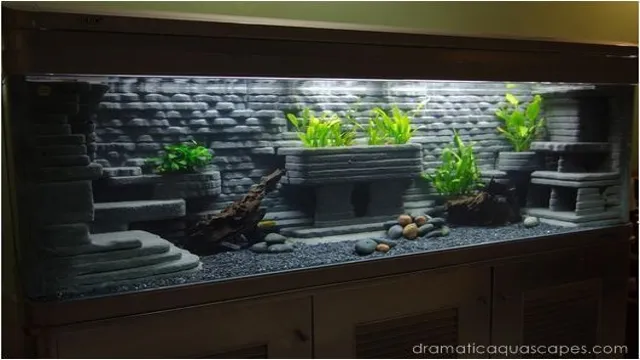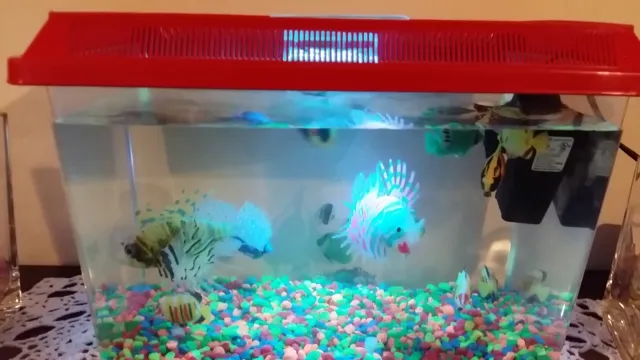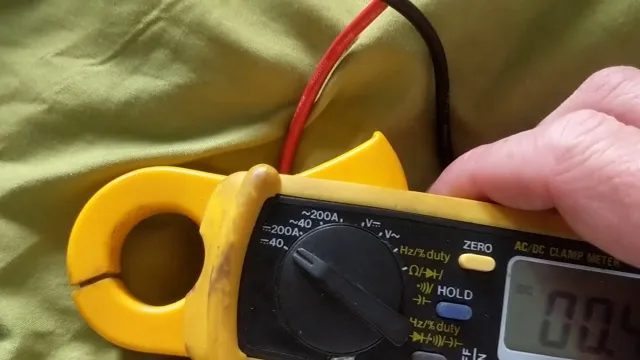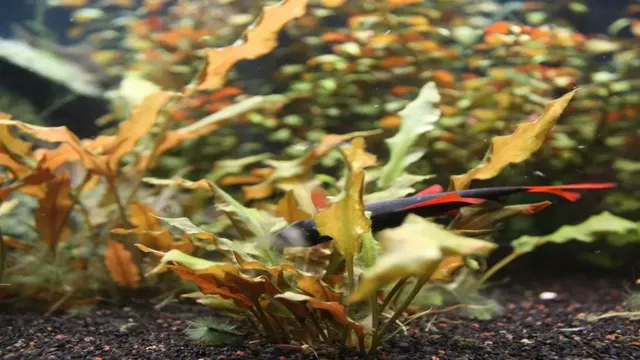If you’re looking for an innovative way to bring the beauty of the ocean into your home, creating an artificial aquarium might be just what you need. A unique alternative to traditional aquariums, artificial aquariums are perfect for those who want to enjoy the benefits of owning an aquarium without the hassle of maintenance or the cost of purchasing live creatures. Not only are these man-made aquariums visually stunning, but they’re also a great way to add a touch of creativity and personality to your living space.
But how do you create an artificial aquarium, and what do you need to get started? Don’t worry – we’re here to break it down for you. Whether you’re a seasoned aquarist or a beginner, we’ll guide you through everything you need to know about artificial aquariums, from selecting the perfect décor to keeping your new aquarium in excellent condition. So sit back, relax, and get ready to dive into the world of artificial aquariums.
Choosing your Tank and Decorations
If you’re looking to set up an artificial aquarium, it’s important to choose the right tank and decorations to create a natural and lively environment for your fish. Start by considering the size of your tank and the type of fish you’ll be keeping. A general rule of thumb is one inch of fish per gallon of water, so make sure you choose a tank that’s big enough for your fish to thrive in.
Next, think about the decorations you want to use. Artificial plants and rocks are great options for creating a natural look without the upkeep of live plants. Make sure the decorations you choose are safe for your fish and won’t harm them in any way.
Once you have your tank and decorations set up, add some water and a filter to keep the environment clean and healthy for your fish. With a little bit of planning and the right materials, you can make a beautiful and low-maintenance artificial aquarium.
Selecting the Right Size Tank
When it comes to selecting the right size tank, it’s important to consider both your fish and the decorations you plan on adding. A general rule of thumb is to ensure your tank can hold at least one gallon of water per inch of fish. However, keep in mind that some species of fish require more space than others.
For example, larger fish like angelfish or cichlids need more room to swim than smaller fish like tetras or guppies. Additionally, consider the decor you plan on adding to your tank. Decorations like plants, rocks, and caves can take up space in the tank and provide hiding spots for your fish.
Make sure there is still plenty of room for your fish to swim freely. By taking into account both your fish and decor, you can ensure you select the right size tank for the health and happiness of your aquatic pets.

Adding Plants and Decorations
When it comes to setting up your aquarium, choosing the right tank and decorations is crucial. The size and shape of your tank will determine the types and number of fish you can have, so consider this carefully before making your choice. Once you’ve chosen your tank, it’s time to add some decorations and plants.
Not only do these add a nice aesthetic touch to your aquarium, but they also provide hiding places for your fish and help to create a more natural environment. When choosing decorations, think about the types of fish you have and what they might appreciate. For example, if you have small fish who like to hide, you might want to add some caves or other hiding spots.
Similarly, if you have fish who like to swim through plants, make sure to add plenty of foliage. Adding plants will not only make your aquarium look more beautiful, but they will also help to create a healthy environment for your fish by absorbing excess nutrients and adding oxygen to the water. Overall, choosing the right tank and decorations is the key to creating a beautiful, healthy home for your aquatic pets.
Installing Essential Equipment
If you’re wondering how to make an artificial aquarium, the first step is to ensure you have all the necessary equipment. This includes a high-quality filter system, lighting, substrate, and decorations to provide a natural-looking environment for your fish. Depending on the size of your aquarium, you will need to invest in the appropriate filter system to keep the water clean and provide oxygen to the fish.
Lighting plays a crucial role in the health and wellbeing of your fish and aquatic plants. Ensure you choose the appropriate lighting system based on the type of fish and plants in your aquarium. Substrate also plays an important role in creating a natural-looking environment for your fish.
Choose a substrate that is appropriate for your fish and helps maintain a healthy and balanced ecosystem. Finally, decorating your aquarium with plants, rocks, and other structures not only creates a natural-looking environment, but also provides hiding spots for your fish, promoting their mental and physical health. By investing in quality equipment, you’ll be well on your way to creating a beautiful and healthy artificial aquarium that both you and your fish will love.
Setting up your Filtration System
Setting up your Filtration System Installing Essential Equipment When setting up your filtration system for your aquarium, it is essential to have the right equipment in place. The first piece of equipment you will need is a good quality filter. Filters come in different shapes and sizes, but all perform the same basic function of removing waste and debris from the water. (See Also: How to Make an Aquarium on Sims 3: The Ultimate Guide to Building the Perfect Underwater World)
When choosing a filter, consider the size of your aquarium, the type of fish you have, and the amount of waste they produce. Additionally, you will need a heater to regulate the temperature of the water, and a thermometer to monitor the temperature. A good lighting system is also crucial for the health of your fish and plants.
Lastly, a powerhead can be added to help circulate the water in the aquarium and create a more natural environment for your aquatic pets. With these essential equipment items in place, you can create a healthy and thriving ecosystem for your fish to enjoy.
Adding Lighting and Heating
When it comes to adding essential equipment to your home, lighting and heating are at the top of the list. Proper lighting is crucial for a comfortable and functional living space. It can affect your mood, productivity, and overall ambiance of the room.
Installing dimmer switches or upgrading to LED lights can help reduce energy costs while adding style to your space. Meanwhile, heating is essential for keeping you and your family warm during the colder months. Installing a central heating system or a fireplace can add warmth and comfort to your home.
You can even opt for smart thermostats to regulate the temperature and save on heating costs. In short, lighting and heating are two critical areas of your home that enhance your comfort and wellbeing, so investing in them is worth it in the long run.
Choosing the Right Substrate
When it comes to setting up your aquarium, choosing the right substrate is essential. Not only does it provide a natural look and feel, but it also has important functions such as providing a surface for beneficial bacteria to grow. Gravel and sand are two popular substrate options.
Gravel is great for larger fish and provides a variety of colors and textures to choose from. Sand is perfect for bottom-dwelling fish and creates a sleek, clean look. Make sure to choose a substrate that is appropriate for your aquarium size and the needs of your fish.
Additionally, be sure to rinse your substrate thoroughly before adding it to your tank to remove any unwanted debris or dust. By taking the time to choose the right substrate, you can create a healthy and beautiful environment for your aquatic friends.
Adding Water and Fish
Making an artificial aquarium can be a fun and rewarding project that can provide a calming addition to your home decor. After you have set up the tank, it’s now time to add water and fish. First, you’ll need to fill the aquarium with water.
Be sure to use water conditioner to remove any harmful chemicals that may be in your tap water. Once you’ve added the water, it’s time to introduce your fish. Make sure you choose fish that are compatible with each other and the size of your tank.
Also, make sure to acclimate your fish to the new water temperature by slowly introducing them to the aquarium over a period of time. Watching your fish happily swim around in their new home can be relaxing and rewarding. So, take your time in selecting the right fish species and add them gradually.
Remember, patience and consistency are key when creating your artificial aquarium.
Preparing the Water Quality
When it comes to setting up an aquarium, adding water and fish is the next crucial step after preparing the water quality. Make sure to add the right amount of water based on the size of the tank and the number of fish you plan to keep. You may also want to consider using a water conditioner to remove harmful chemicals that could harm your fish.
Once the water is added, it’s best to let the tank settle for a few hours before adding fish, as this will allow the temperature to stabilize. Adding fish too soon could cause stress or even death. When it’s time to add fish, do so gradually to minimize shock.
Introducing too many fish at once can cause a spike in ammonia levels, putting your fish at risk. Remember, setting up an aquarium takes time and patience, but the end result is a beautiful and peaceful addition to any home. (See Also: How to Make Aquarium Water Less Alkaline in 5 Simple Steps)
Choosing the Right Fish
Choosing the right fish to add to your aquarium can be quite a challenge, but it’s important to ensure that you pick the right ones to create an environment that’s safe, healthy, and happy for your aquatic friends. You need to take into account factors such as the size of your tank, the water temperature, and the behavior of the fish you want to add when making your decision. It’s important to avoid putting fish together that are aggressive towards each other or that require drastically different water conditions, as this can lead to stress, sickness, or even death.
Research the fish you’re interested in and seek advice from aquarium experts to make sure that you’re making the best choices for your tank. Remember, the right fish can bring a lot of joy and beauty to your aquarium, so take your time and choose wisely!
Maintaining your Aquarium
Making an artificial aquarium can seem overwhelming at first, but with the right tools and some patience, it can be a fun and rewarding project. The first step is selecting the proper container such as a glass or acrylic fish tank. Then, choose the appropriate lighting, filtration, and heating systems for your specific type of fish and plants.
Next, pick out a substrate that will provide adequate drainage and nutrients for your plants. Adding live or artificial decorations such as rocks, plants, and driftwood will give your aquarium a natural feel. Maintaining the aquarium involves regular water changes, cleaning the filters, and monitoring the temperature and pH levels.
With a little effort and creativity, you can construct a beautiful and healthy artificial aquarium that will provide years of enjoyment for both you and your fish.
Regular Water Changes and Cleaning
Maintaining your aquarium is one of the most essential things you can do to ensure your fish stay healthy and happy. Regular water changes and cleaning are crucial for the maintenance of your aquarium. Water changes help remove harmful toxins, and they also replace lost minerals and nutrients that the fish require to stay healthy.
Cleaning your aquarium’s accessories, such as the filter, light, and substrate, can help get rid of decaying debris and prevent the build-up of harmful bacteria. It would be best to perform regular water changes and cleanings to keep your aquarium clean and healthy. Doing so not only ensures your fish’s well-being but also enhances the overall aesthetics of your aquarium.
Therefore, it is essential to stick to a regular cleaning and maintenance routine to avoid any potential problems and enjoy a beautiful and healthy aquarium.
Monitoring Fish Health and Behavior
Maintaining Your Aquarium: Monitoring Fish Health and Behavior When it comes to maintaining your aquarium, monitoring your fish’s health and behavior is essential. After all, you want to ensure that your fish are happy and healthy in their aquatic environment. There are a few things to keep an eye on when it comes to your fish’s health and behavior.
First and foremost, keep a close eye on what your fish are eating. Are they eating regularly? Are they showing any indications of refusing food? If so, this can be a sign of illness. Additionally, be sure to keep a schedule for cleaning your aquarium to avoid bacterial growth and other issues.
Another aspect of monitoring your fish’s health and behavior is observing their swimming patterns. Are they swimming erratically or bumping into things? This could be a sign of stress, illness, or water quality issues. Keeping your water levels consistent is crucial for the health and happiness of your fish.
Lastly, keep an eye out for any changes in appearance, such as discoloration, visible parasites, or wounds. These can all be indications of illness, stress, or poor water quality. If you notice anything out of the ordinary, it’s essential to address it promptly to avoid further complications.
Overall, maintaining your aquarium requires diligence and attention to detail. By monitoring your fish’s health and behavior regularly, you can ensure that they thrive in their aquatic environment. With a little bit of effort and care, your aquarium can be a beautiful and healthy addition to your home.
Troubleshooting Common Problems
Maintaining your aquarium is crucial to ensure the longevity and health of your aquatic pets. However, maintaining an aquarium can be a daunting task for beginners. Common problems that arise include cloudy water, algae growth, and pH imbalances. (See Also: How to Know If Your Aquarium Is Cycled: A Comprehensive Guide for Fishkeepers)
To prevent cloudy water, make sure to clean your aquarium’s filter regularly and avoid overfeeding your fish. Algae growth can be controlled by monitoring the amount of light your aquarium receives and by adding algae eaters to the ecosystem. pH imbalances can be corrected by regularly testing the water and adjusting it with appropriate chemicals.
Another common issue is fish illnesses, which can be prevented by maintaining a clean aquarium and regularly checking your fish for any signs of illness or stress. By taking these measures, you can ensure a happy and healthy aquarium for your aquatic pets.
Conclusion
In conclusion, creating an artificial aquarium is no easy task, but with the right ingredients, patience, and creativity, it can be a fun and rewarding experience. From selecting the perfect aquarium size to adding the right lighting and décor elements, every step of the process requires careful consideration. Just remember, fish are not only beautiful to look at, but they also require a clean and healthy environment to thrive in.
So, take your time, get inspired, and dive into the world of artificial aquariums like a fish in water!”.
FAQs
What are the benefits of having an artificial aquarium at home?
Having an artificial aquarium at home can bring peace and tranquility, reduce stress, and provide a beautiful aesthetic addition to any space.
How do I choose the right artificial plants for my aquarium?
Look for plants that are realistic, durable, and safe for aquatic life. Consider the size and style of plants you want, as well as their compatibility with your aquarium’s lighting and water parameters.
Can I use regular tap water in my artificial aquarium?
It depends on the specific needs of your aquatic life and the additives of your tap water. You may need to treat the water regularly to maintain proper pH levels and ensure the health of your fish and plants.
Do I need special lighting for my artificial aquarium?
Yes, you will need proper lighting to support the growth and health of your artificial plants and fish. LED lights are a popular and energy-efficient option for aquariums.
How often should I clean my artificial aquarium?
Regular maintenance, including water changes and cleaning debris from the tank, is necessary to ensure the health of your aquatic life. Aim to clean your aquarium every few weeks or as needed.
Are there any potential risks or drawbacks to having an artificial aquarium?
Artificial aquariums require regular maintenance and attention, and equipment can be expensive. Additionally, they do not provide the same benefits as a real, live aquarium, such as natural filtration and interaction with living creatures.
How can I create a natural-looking environment in my artificial aquarium?
To create a natural-looking environment in your aquarium, consider adding rocks, sand or gravel, and driftwood. Incorporating natural-looking plants and using soothing lighting can also help create a peaceful aquatic environment.







